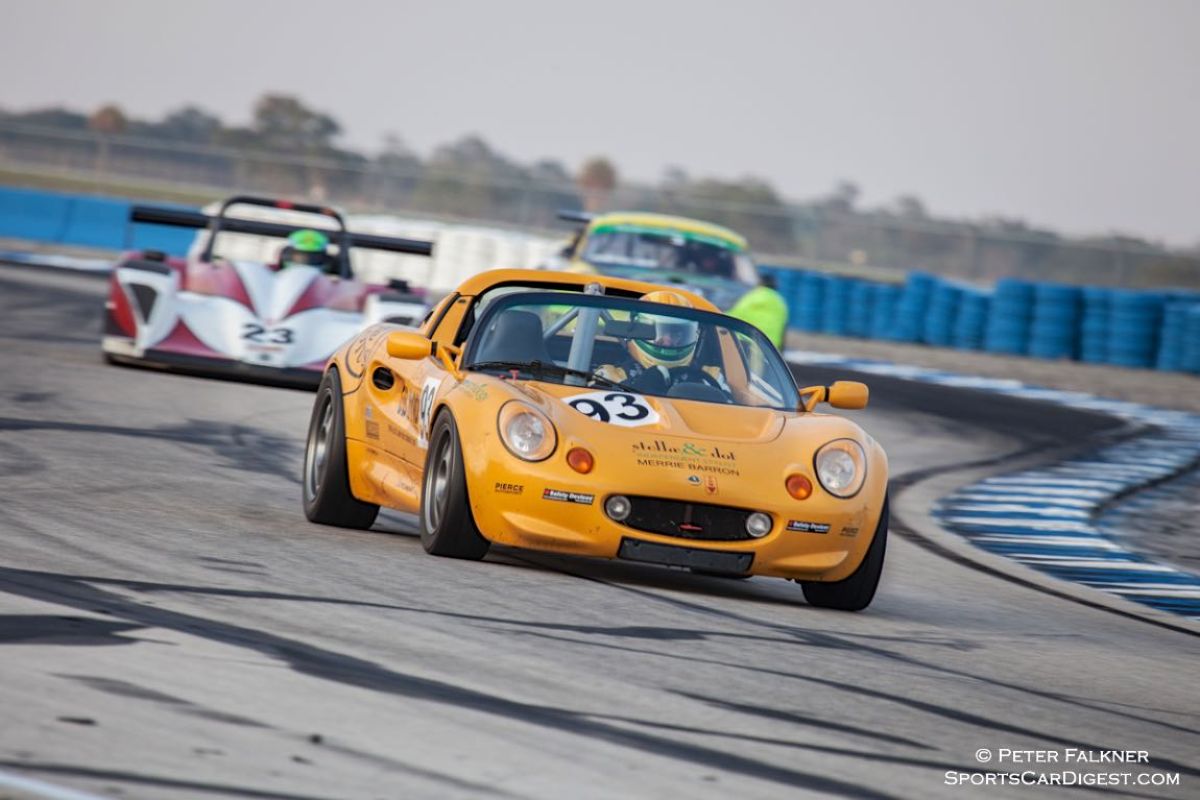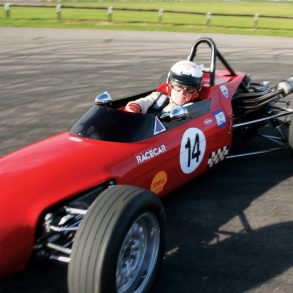Imagine it’s the mid-1990s again and cars were still somewhat raw. The rapid development of technology brought computers into our households, although these devices remained too large and bulky to be crammed into our pockets and dashboards. On the other hand, these optimistic times brought us a new, somehow confusing design in which the designers were still trying to depart from the razor-sharp 1970s and 1980s. It seemed like it was the final moment in time when no-nonsense simple fun cars were created when Lotus came out with a product that looked and acted like a supercar but was a bare-bones featherweight in its essence. That car was none other than the Lotus Elise.
Add lightness – The Philosophy of Lotus
Ever since the famous and much recreated Lotus 7, the company relied on one goal both on the tracks and in its plate-bearing cars. Lotus founder Colin Chapman famously said “Simplify, then add lightness” and it was a straightforward philosophy that kept Lotus fun, agile, and immersive without being too complicated or overpowered.

This approach stood the test of time surprisingly well and Lotus kept its relevance to this day since the Elise is still the bread and butter of the Lotus lineup.
Development of the Lotus Elise
Even before Colin Chapman’s sudden passing in late 1982, Lotus was battling financial trouble and was even involved in the DMC controversy. Despite that, Lotus was held in high regard in the automotive world and the company successfully overcame all hardships, albeit under various owners, the biggest one being General Motors.
The pivotal point for the development of the Elise came when GM sold the Lotus to A.C.B.N. Holdings S.A, a company run by Romano Artioli who happened to own Bugatti at the same time. Under his guidance, the development of the Type 111 began.

The idea behind the Elise was to build a lightweight, simple and above all affordable sports car relying on Lotus’ rich heritage, yet to make it exciting in terms of looks and driving appeal.
Since its inception, Lotus cars have used various bits and pieces from all over the industry, sharing parts with the likes of Renault, Toyota, Ford and Rover. This time too, the engineers sourced for components that could lower the final production costs while still being within the required performance threshold.
The basic layout of the Elise was nothing revolutionary, let alone by Lotus’ standards. The fiberglass body bonded to a lightweight chassis and fitted with a mid-mounted revvy engine were an already known recipe for successful sports cars, but what made the Type 111 Elise so special then?

It’s all about putting the Elise into context. Lightweight sports cars with a small displacement engine were a British trademark since WW2 and many cars from all around Europe successfully followed the same mantra. But, by the time the Elise was introduced, a majority of companies couldn’t find a way around tightening safety standards. Also, the market demanded more comfort, convenience, and other luxuries, so the cars grew in size and weight.
There was still a market for pure sports cars, yet it was more limited than before. The Elise managed to surpass all expectations and become the best selling Lotus ever created.
The first Elise debuted at the 1995 Frankfurt Motor Show and was a much-needed refreshment for the company. The M100 Elan developed under GM didn’t deliver the expected Lotus experience, so a return to the roots under Artioli proved to be a hit. Finally, following the tradition of road car names starting with an E, Romano Artioli named the car Elise after his granddaughter, Elisa.

Chassis and Body
It was Julian Thomson who executed the design of the fiberglass body while the chief engineer of the car was Richard Rackham. Being both good friends and colleagues, the duo truly simplified the Lotus, then added lightness. The chassis was a stiff and lightweight, yet incredibly simple high-sided tub with transverse torque boxes at both ends, weighing just 150 lbs.
Lotus was able to achieve such a lightweight chassis by gluing the parts together rather than welding the parts. By using of adhesives, instead of welding, the extrusions could be made thinner.
The use of adhesives along with lightweight aluminum extrusions to construct the chassis was revolutionary.

To keep the total weight of the car as low as possible, steel was used just for the roll-bar, suspension mounts and rear subframe of the car. The final result was a car weighing under 1653 lbs, with stunning Lotus-worthy looks, low center of gravity measuring 18.5 in, exceptional structural stiffness and low production costs.
Such clever engineering enabled Lotus to focus on perfecting handling rather than chase brute power. A very Lotus-like move indeed, it proved to be a successful formula since the Elise could outperform more powerful and more expensive sports cars of the era.
Engine of the Elise
Throughout the history of the Elise, there have been several changes of the powertrain. Before we go into greater detail, let’s talk about the first engine used in the Elise. It was a Rover K series four-cylinder with a humble power output of 118 brake horsepower. Still, in a car weighing less than a metric ton, the 0-60 time was just 5.5 seconds which was quite an impressive number for the era.

Later iterations brought more power, and more power brought more impressive performance. As Lotus changed ownership and made other development deals to keep afloat, the engines and transmission units were sourced from Toyota starting from Series 2 until today.
Interior of the Elise
In order to leave the Elise in the featherweight division, the engineers had to make numerous compromises. That being said, the interior of the Lotus Elise was Spartan, with a bare minimum of required features. Parts of the car aren’t even upholstered and you won’t find luxuries like electric windows, but what you will find are sports seats, a simple instrument cluster, an airbag-free steering wheel, three drilled pedals, a manual gearbox, and a handbrake.

Basically speaking, Lotus wasn’t ever envisioned to be a daily driver, at least not a comfortable one, but a fun, sensibly reliable, and affordable weekend basher that has everything you need from a track car. Oh yes, you will sometimes find it with a radio.
Lotus Elise – Throughout the Years
During its lifespan that lasts until this day, the Elise was constantly tweaked and updated. Still, this sports car can be broken down into three separate generations distinguishable by its looks, powertrains, and safety standards.
Series 1
The original Series 1 Lotus Elise debuted at the 1995 Frankfurt Motor Show and it stayed in production until 2001.

Sadly, Romano Artioli couldn’t enjoy the success of the Elise. In 1997, he was forced to sell the company to Proton in order to cover the debts accumulated during a financially disastrous Bugatti venture that gave us the EB110 as a silver lining. As a result of this trade, some Lotus Elise S1 examples were built as kits in Malaysia and exported to neighboring markets.

As previously mentioned, the Series 1 Lotus Elise was powered by a 1.8 liter 4-cylinder Rover K series stuffed in the middle and mated to a close-ratio 5-speed manual. In base form, the power output was 118 horsepower, but for those who wanted more, Lotus produced even more focused Elises named Sport 135, Sport 160 and Sport 190.
These cars produced 145, 160, and 190 horsepower respectively, but the improvements didn’t stop there. Grippier tires, lightweight wheels, and stiffer suspensions gave these cars more capable on-track performance, at the price of being even more uncomfortable in daily traffic. These three cars should not be confused with other, more radically improved special editions.

Lotus Elise 111S
The first special edition Elise is the 111S, a car with a revised K-Series engine and gearbox and minor cosmetic and functional changes.

This car benefited from variable valve timing, closer-ratio gearbox, and reduced final drive gear – the revisions that made the Lotus 111S accelerate quicker. The power output of the car is 143 horsepower, a hefty upgrade given the fact that the weight remained the same.
Lotus Elise 340R
Lotus collectors and enthusiasts will certainly look for the limited run of 340 examples of the most focused Series 1 Elise – the 340R.
This car had a thoroughly revised body resulting in an otherworldly look with exposed wheels and no doors. These cars were envisioned for racing and track use alone and there’s a slim chance you’ll find any of them in street use.

The 340R was powered by the same 1.8l K-Series, but in VHPD (Very High Power Derivative) variant and its name was originally meant to reflect the metric power-to-weight ratio of the original concept which produced 177 ponies in a 1,102 lb body. However, as the production cars weighed 1,545 lb Lotus switched to producing 340 examples. There was, however, an upgrade pack that trimmed the weight down to 1,259 lb and gave the engine 192 horsepower, so Lotus did manage to fulfill its promise to selected customers.
Lotus Exige
Built on the S1 Lotus Elise platform, the Exige was a limited-run hardtop version with the 340R-sourced 177 horsepower 1.8 VHPD K-Series. The Exige was built in 602 copies from 2000 to 2004.

Lotus Elise GT1
Trying to live up to its racing heritage, Lotus created a GT1 class race car, but the company couldn’t compete with more experienced and better-funded adversaries.

Only one street and seven race cars were built, while two GT1 chassis were converted into V10-powered Bitter GT1 cars. A Holy Grail among the Elise S1 lineup, the street version GT1 is probably located in a private collection in the Netherlands.
Heritage Editions
In the Series 1 production spans, there were three editions bearing three of the most distinct Lotus colorways.
The first one was the 50th Anniversary with a pearlescent British Racing Green and golden five-spoke wheels. It remained mechanically the same as the base S1 Elise.
The most prominent edition was Type 49, paying homage to the eponymous F1 car. This special edition Elise was painted in Gold Leaf Tobacco color scheme with the red, white and gold bodywork and six-spoke 111s wheels.

Inside, the seats and the steering wheel were upholstered in red perforated leather and door cards were finished in black Alcantara. Limited to the UK market only, this special edition was built in 100 examples in 1999.

In the same year, Lotus unveiled the Type 79 edition too, limited to 150 examples, 100 in left-hand drive and 50 in right-hand drive. The car evoked the JPS F1 car and as such, it was painted in black with golden six-spoke 111S wheels and black on gold interior Alcantara-clad interior.
Series 2
By 2000, both European and North American safety regulations deemed the S1 Elise unsafe, so the car had to be revised in order to be sold as a road car. Now under the ownership of the Malaysian Proton car company, Lotus again had to look for a big partner to overcome this obstacle.

The company once again looked to GM which gave the necessary funding in exchange for Lotus providing the Elise chassis technology for the Opel Speedster and Vauxhall VX220.
The S2 Lotus Elise was largely based on the S1 model, but with further improvements to the chassis and the powertrain. In its base trim, the Elise still had a 1.8l K-Series engine, now producing 120 horsepower. During the production cycle, the Elise S2 got Toyota engines, the 1.8 liter 1ZZ-FE unit for the European market and 2ZZ-GE for North America.
Lotus Elise 111S
The 111S was now an upgraded Elise trim which featured variable valve timing technology, upping the power to 160 horses.

Lotus Elise 111R
The 111R variant of the S2 Elise marked a switch from Rover to Toyota engines. The baseline 111R Lotus Elise S gets 189 horsepower coming from a 1.8 liter 2ZZ-GE engine with a twin-cam head setup designed by Yamaha. The advanced head had variable valve timing and combined with Lotus-programmed ECU, the 111R had better power delivery. These variants of the 111R were mated to 6-speed manual transmission and could do 0-60 in 4.9 seconds.
From 2008 onwards, the Elise S was joined by a more powerful Elise SC. This car had a supercharged non-intercooled 2ZZ-GE now pushing 218 horsepower, enough for a respectable 0-60 Sprint of 4.3 seconds.
Special Editions
Like its predecessor, the S2 Elise also had several heritage editions, the first being Type 25 British Racing Green with two yellow stripes limited to 50 RHD examples.
In 2003, Lotus followed with the 50-example Type 23, featuring white bodywork and two green stripes running the full length of the car.

Stateside, Lotus tried to appeal to the lifestyle market by launching the California Edition Elise. This edition was limited to 50 pieces, 25 in Ardent Red, and 25 in Saffron Yellow. Both cars had subtle retro touches inspired by the 1960s Ferrari, such as 16-spoke wheels and silver front grille design. Even the interiors were inspired by the prancing horses of Maranello, as they were upholstered in beige two-tone leather.
Series 3
Built from 2011, the Series 3 was also the last Elise available in the US. Only the first model year cars could be legally bought stateside, and they were powered by the same 136 horsepower 1.8 liter 2ZZ GE, whereas the European models got the 1.6 liter 1ZR FAE.

Design-wise, the Elise ditched the trademark fascia in favor of more modern character lines. Future collectors will keep an eye on the special Cup 220, Cup 250 and Cup 260 editions, all bearing numerous upgrades primarily for track use.

It’s still very early to put these focused Elises on a collector car map, but we’re certain that the Elise will still have a strong cult following even twenty or more years from now.
Since the very beginning, the Lotus Elise has been a definitive modern classic and a very special kind of driver’s car. It stayed true to the Lotus founder by offering affordable performance, clever design, and unique looks.
Even in its evolution, the Elise still follows the basic principle and keeps reminding us that simple cars can be fun when there’s intelligent engineering involved. The Series 1 is a true modern classic, especially in its nostalgic limited editions or track focused 340R version, whereas the Series 2 and Series 3 cars are cars you should keep an eye out if you want to have an affordable weekend fun car.











There were also the Honda conversions that could provide 200 hp From the B18 and K20 engines. Sun Speed made a do it yourself kit for the conversions.
I bought a 2014 series 3 Elise S. Having driven a few brilliantly engineered vehicles over the years there is nothing like the Elise. It’s handling, responsiveness, feedback and interior engineering/layout cannot be faulted.
Approaching 70 years, I hope for many more years of enjoyment.